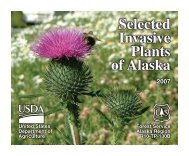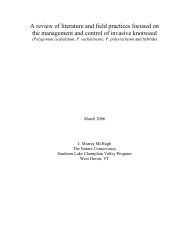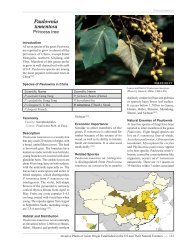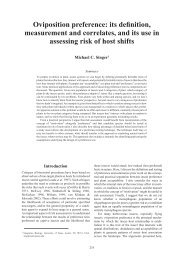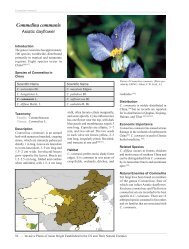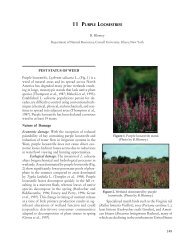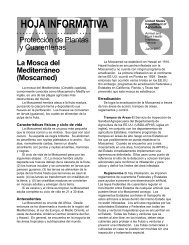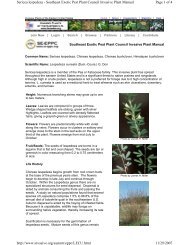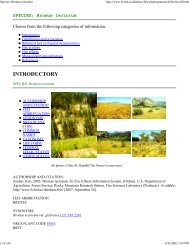Post-release evaluation of invasive plant biological control agents in ...
Post-release evaluation of invasive plant biological control agents in ...
Post-release evaluation of invasive plant biological control agents in ...
Create successful ePaper yourself
Turn your PDF publications into a flip-book with our unique Google optimized e-Paper software.
<strong>Post</strong>-<strong>release</strong> <strong>evaluation</strong> <strong>of</strong> <strong><strong>in</strong>vasive</strong> <strong>plant</strong><br />
<strong>biological</strong> <strong>control</strong> <strong>agents</strong> <strong>in</strong> BC us<strong>in</strong>g IAPP,<br />
a novel database management platform<br />
S.C. Turner<br />
Summary<br />
When faced with the <strong>in</strong>vasion <strong>of</strong> alien <strong>plant</strong> species, the government <strong>of</strong> British Columbia (BC) uses<br />
the pr<strong>in</strong>cipals <strong>of</strong> Integrated Pest Management: prevention, early detection rapid response, <strong>in</strong>ventory<br />
surveys and mechanical, chemical and <strong>biological</strong> <strong>control</strong> treatments. The BC government’s Invasive<br />
Alien Plant Program (IAPP) application houses the data for management <strong>of</strong> <strong><strong>in</strong>vasive</strong> alien <strong>plant</strong>s,<br />
<strong>in</strong>clud<strong>in</strong>g plann<strong>in</strong>g, <strong>in</strong>ventory, mechanical, chemical and <strong>biological</strong> <strong>control</strong>, the monitor<strong>in</strong>g <strong>of</strong> each<br />
<strong>of</strong> these activities and <strong>biological</strong> <strong>control</strong> agent dispersal. The IAPP Application is structured to track<br />
sites and their characteristics as geographic locations. Multiple <strong><strong>in</strong>vasive</strong> species with multiple surveys<br />
can be entered for a s<strong>in</strong>gle site. This allows record<strong>in</strong>g <strong>of</strong> the change <strong>in</strong> the <strong><strong>in</strong>vasive</strong> <strong>plant</strong> community<br />
over time and the level <strong>of</strong> success <strong>of</strong> treatment efforts. A compilation <strong>of</strong> this data allows assessment<br />
<strong>of</strong> the current set <strong>of</strong> <strong>biological</strong> <strong>control</strong> <strong>agents</strong> for target <strong>plant</strong> species. By compar<strong>in</strong>g the spread <strong>of</strong><br />
Dalmatian toadflax, L<strong>in</strong>aria dalmatica L. Miller, to the habitat requirements <strong>of</strong> its <strong>biological</strong> <strong>control</strong><br />
<strong>agents</strong>, it is possible, us<strong>in</strong>g IAPP, to determ<strong>in</strong>e whether sufficient, suitable <strong>agents</strong> exist <strong>in</strong> the prov<strong>in</strong>ce<br />
or whether additional screen<strong>in</strong>g <strong>of</strong> <strong>agents</strong> must be pursued.<br />
Keywords: Dalmatian toadflax, <strong>biological</strong> <strong>control</strong> agent habitat requirements, spatial<br />
mapp<strong>in</strong>g.<br />
Introduction<br />
The Crown public lands <strong>of</strong> British Columbia (BC)<br />
consist <strong>of</strong> approximately 885,600 km 2 or 93% <strong>of</strong> the<br />
prov<strong>in</strong>ce (BC M<strong>in</strong>istry <strong>of</strong> Susta<strong>in</strong>able Resource Management,<br />
1997). When faced with the <strong>in</strong>vasion <strong>of</strong> alien<br />
<strong>plant</strong> species, BC employs the pr<strong>in</strong>cipals <strong>of</strong> Integrated<br />
Pest Management: prevention, early detection rapid<br />
response (EDRR), <strong>in</strong>ventory surveys and a multitude<br />
<strong>of</strong> treatment tools <strong>in</strong>clud<strong>in</strong>g mechanical, chemical and<br />
<strong>biological</strong> <strong>control</strong>. For example, upon <strong>in</strong>itial sight<strong>in</strong>gs<br />
<strong>of</strong> an <strong><strong>in</strong>vasive</strong> alien species, mechanical treatment may<br />
be used when the <strong>in</strong>festation is <strong>of</strong> a size to be managed<br />
by this method or when the <strong>plant</strong>s reside <strong>in</strong> a herbiciderestricted<br />
area. Herbicide treatment is a necessary and<br />
effective tool that is used judiciously.<br />
British Columbia’s legislation for herbicide use,<br />
adm<strong>in</strong>istered and enforced by the M<strong>in</strong>istry <strong>of</strong> Envi-<br />
M<strong>in</strong>istry <strong>of</strong> Forests and Range, 515 Columbia Street, Kamloops, BC,<br />
Canada V1S 1E6.<br />
Correspond<strong>in</strong>g author: S. Turner .<br />
© CAB International 2008<br />
ronment, is protective <strong>of</strong> the natural environment. For<br />
example, the pesticide-free zone required around or<br />
along bodies <strong>of</strong> water, dry streams and classified wetlands<br />
is 10 m, and BC has no herbicides registered for<br />
use aga<strong>in</strong>st <strong><strong>in</strong>vasive</strong> <strong>plant</strong>s <strong>in</strong> water. When an <strong><strong>in</strong>vasive</strong><br />
alien species has spread to an area where repeated<br />
spray<strong>in</strong>g is not economical, a conta<strong>in</strong>ment strategy is<br />
employed. Under this strategy, a perimeter boundary<br />
around an <strong>in</strong>festation is established, and no mechanical<br />
or chemical treatment is carried out with<strong>in</strong> the<br />
perimeter except <strong>in</strong> special circumstances. Any <strong><strong>in</strong>vasive</strong><br />
<strong>plant</strong> found beyond the boundary is aggressively<br />
treated.<br />
Once an <strong><strong>in</strong>vasive</strong> species has spread beyond the<br />
ability to manage it with mechanical or chemical treatment<br />
methods, the area is considered to require restoration.<br />
Restoration <strong>of</strong> <strong>in</strong>fested areas is pursued through<br />
the use <strong>of</strong> good resource management practices and<br />
the encouragement <strong>of</strong> healthy <strong>biological</strong> <strong>control</strong> agent<br />
populations, where available.<br />
BC M<strong>in</strong>istry <strong>of</strong> Forests and Range (MFR) staff<br />
<strong>in</strong>teract with scientists <strong>in</strong> the Canadian and <strong>in</strong>ternational<br />
community pursu<strong>in</strong>g <strong>biological</strong> <strong>control</strong> <strong>agents</strong><br />
625
XII International Symposium on Biological Control <strong>of</strong> Weeds<br />
for <strong><strong>in</strong>vasive</strong> alien <strong>plant</strong> species <strong>of</strong> concern. Consortia<br />
are formed, comprised <strong>of</strong> fund<strong>in</strong>g agencies, national<br />
researchers and <strong>in</strong>fluential stakeholders that plan and<br />
pursue <strong>biological</strong> <strong>control</strong> research. The <strong><strong>in</strong>vasive</strong> <strong>plant</strong>’s<br />
country <strong>of</strong> orig<strong>in</strong> is <strong>in</strong>vestigated for <strong>in</strong>sects and pathogens<br />
that are found to attack the target <strong>plant</strong> species.<br />
Through cooperative efforts, BC funds research to ensure<br />
that <strong>biological</strong> <strong>control</strong> <strong>agents</strong> are specific to the<br />
target <strong>plant</strong>, that is, they will not <strong>in</strong>flict major damage<br />
to other Canadian <strong>plant</strong>s <strong>of</strong> economic or environmental<br />
importance.<br />
When new <strong>biological</strong> <strong>control</strong> <strong>agents</strong> have passed<br />
the screen<strong>in</strong>g process and approval for importation has<br />
been obta<strong>in</strong>ed, they are shipped <strong>in</strong>to the country, passed<br />
through the Agriculture and Agri-Food Canada quarant<strong>in</strong>e<br />
facility at Lethbridge, Alberta and received <strong>in</strong><br />
British Columbia. Once <strong>in</strong> British Columbia, the <strong>agents</strong><br />
are <strong>release</strong>d at pre-determ<strong>in</strong>ed sites for optimum establishment.<br />
These sites are determ<strong>in</strong>ed from <strong>in</strong>formation<br />
on the agent’s native habitat, <strong>in</strong>vestigation <strong>in</strong>to the<br />
prov<strong>in</strong>cial government’s Invasive Alien Plant Program<br />
(IAPP) application and field <strong>in</strong>vestigation. The <strong>release</strong><br />
sites are <strong>in</strong> turn tracked <strong>in</strong> the IAPP Application.<br />
The IAPP Application (http://www.for.gov.bc.ca/<br />
hfp/<strong><strong>in</strong>vasive</strong>/<strong>in</strong>dex.htm), launched <strong>in</strong> fall 2005, is a<br />
web-based Oracle application that houses data associated<br />
with the <strong>in</strong>tegrated weed management processes.<br />
Information is entered <strong>in</strong>to the IAPP application for<br />
<strong>in</strong>dividual sites <strong>in</strong>clud<strong>in</strong>g their geographical characteristics<br />
and <strong><strong>in</strong>vasive</strong> <strong>plant</strong> species. Data on multiple<br />
<strong>in</strong>vasions from surveys that assess the management<br />
strategies can be <strong>in</strong>cluded for each site. This creates a<br />
record <strong>of</strong> the change <strong>in</strong> the <strong><strong>in</strong>vasive</strong> <strong>plant</strong> populations<br />
over time and allows <strong>evaluation</strong> <strong>of</strong> the level <strong>of</strong> success<br />
<strong>of</strong> management practices.<br />
The IAPP application consists <strong>of</strong> two components:<br />
a password-protected Data Entry module and a Map<br />
Display module that is accessible to the public. Collaborat<strong>in</strong>g<br />
organizations may be given access to IAPP<br />
to record <strong>in</strong>formation. The <strong>in</strong>formation is visible to all<br />
participants but is protected from manipulation. Efforts<br />
to manage <strong><strong>in</strong>vasive</strong> alien <strong>plant</strong>s can, therefore, be coord<strong>in</strong>ated<br />
among all participants.<br />
For applied <strong>biological</strong> <strong>control</strong>, sites are chosen where<br />
there is a m<strong>in</strong>imal chance <strong>of</strong> conflict<strong>in</strong>g treatments occurr<strong>in</strong>g<br />
and after consider<strong>in</strong>g habitat-requirement <strong>in</strong>formation.<br />
The latter <strong>in</strong>formation is obta<strong>in</strong>ed from<br />
screen<strong>in</strong>g and petition documents, field staff and from<br />
the Biogeoclimatic Ecosystem Classification (BEC) system,<br />
which is viewed as a layer <strong>in</strong> the IAPP application.<br />
The BEC (http://www.for.gov.bc.ca/hre/becweb/) system<br />
groups ecosystems <strong>in</strong>to hierarchical classifications.<br />
A unit with<strong>in</strong> the BEC system is def<strong>in</strong>ed as a particular<br />
<strong>plant</strong> community and its associated physiography, soil<br />
and climate (Meid<strong>in</strong>ger and Pojar, 1991).<br />
Biological <strong>control</strong> agent <strong>release</strong>s are recorded <strong>in</strong>to<br />
the IAPP’s Data Entry module. The sites are viewed<br />
spatially <strong>in</strong> IAPP’s Map Display as polygons <strong>of</strong> various<br />
sizes to represent, from small to large: a Universal<br />
Transverse Mercator (UTM) co-ord<strong>in</strong>ate; a ‘protected’<br />
location for <strong>biological</strong> <strong>control</strong> <strong>agents</strong> that have yet to<br />
establish; and the size and shape <strong>of</strong> an <strong><strong>in</strong>vasive</strong> <strong>plant</strong><br />
<strong>in</strong>festation. Thereafter, a site is monitored to determ<strong>in</strong>e<br />
if the agent has established and whether any change has<br />
occurred <strong>in</strong> the density, area or distribution <strong>of</strong> the target<br />
<strong><strong>in</strong>vasive</strong> <strong>plant</strong>.<br />
Additionally, the IAPP application can house <strong>biological</strong><br />
<strong>control</strong> agent dispersal <strong>in</strong>formation. Dispersal<br />
<strong>in</strong>formation is used to determ<strong>in</strong>e locations for the collection<br />
and redistribution <strong>of</strong> <strong>biological</strong> <strong>control</strong> <strong>agents</strong>.<br />
Altogether, the spatial <strong>in</strong>formation displayed <strong>in</strong> the<br />
IAPP application allows for an <strong>in</strong>creased understand<strong>in</strong>g<br />
<strong>of</strong> the habitat requirements <strong>of</strong> particular <strong>biological</strong><br />
<strong>control</strong> <strong>agents</strong>. Predictions can be made <strong>of</strong> the agent’s<br />
ability to colonize different habitat types and locations.<br />
This can give <strong><strong>in</strong>vasive</strong> <strong>plant</strong> managers and scientists direction<br />
for pursu<strong>in</strong>g new <strong>biological</strong> <strong>control</strong> <strong>agents</strong> and<br />
the habitat types they are required to fill. An example<br />
<strong>of</strong> how the IAPP application is be<strong>in</strong>g used can be seen<br />
<strong>in</strong> the case <strong>of</strong> the <strong><strong>in</strong>vasive</strong> Dalmatian toadflax, L<strong>in</strong>aria<br />
dalmatica L. Miller, and its complement <strong>of</strong> <strong>biological</strong><br />
<strong>control</strong> <strong>agents</strong>, <strong>in</strong> particular the stem weevil, Mec<strong>in</strong>us<br />
janth<strong>in</strong>us Germar, and the seed weevil, Rh<strong>in</strong>usa antirrh<strong>in</strong>i<br />
(Paykull).<br />
Dalmatian toadflax is a short-lived perennial herb<br />
that was <strong>in</strong>troduced as an ornamental <strong>in</strong> the United<br />
States <strong>in</strong> 1894. It orig<strong>in</strong>ates from the Mediterranean region,<br />
from Yugoslavia to Iran (Robocker, 1974). Dalmatian<br />
toadflax spreads by creep<strong>in</strong>g root stock and seeds,<br />
each <strong>plant</strong> potentially produc<strong>in</strong>g up to 500,000 seeds<br />
(Robocker, 1974) that are dispersed ma<strong>in</strong>ly by w<strong>in</strong>d<br />
and brows<strong>in</strong>g animals. Mature <strong>plant</strong>s are 60 to 120 cm<br />
tall. The stems, several per <strong>plant</strong>, are smooth and lightgreen,<br />
and the flowers are ‘snapdragon’ shaped (Powell<br />
et al., 1994). The <strong>plant</strong> is toxic to livestock, and cattle<br />
tend to avoid graz<strong>in</strong>g on <strong>in</strong>fested pastures (Mason and<br />
Huber, 2002).<br />
Dalmatian toadflax is a stress-tolerant <strong>plant</strong> able to<br />
grow <strong>in</strong> conditions <strong>of</strong> low temperature, coarse soils<br />
and summer drought. It exists <strong>in</strong> the BC BEC zones<br />
<strong>of</strong> Bunchgrass, Ponderosa p<strong>in</strong>e, Interior Douglas-fir,<br />
Interior cedar-hemlock, Coastal Douglas-fir, Coastal<br />
Western hemlock, Montane spruce and the Sub-boreal<br />
spruce.<br />
Efforts to acquire <strong>biological</strong> <strong>control</strong> <strong>agents</strong> for BC<br />
Dalmatian toadflax began <strong>in</strong> the 1960s (Mason and<br />
Huber, 2002). S<strong>in</strong>ce then, seven <strong>agents</strong> have been<br />
screened, and these have been <strong>release</strong>d or have arrived<br />
adventively <strong>in</strong> the prov<strong>in</strong>ce. In particular, M. janth<strong>in</strong>us<br />
(stem-bor<strong>in</strong>g weevil) was <strong>in</strong>troduced <strong>in</strong> 1991, and<br />
R. antirrh<strong>in</strong>i (seed-feed<strong>in</strong>g weevil) was <strong>in</strong>troduced <strong>in</strong><br />
1993. These two species are actively be<strong>in</strong>g redistributed<br />
across the prov<strong>in</strong>ce.<br />
In its native (European) distribution, M. janth<strong>in</strong>us<br />
was recorded resid<strong>in</strong>g <strong>in</strong> a wide range <strong>of</strong> habitat types.<br />
It has been recorded from just below the subalp<strong>in</strong>e zone<br />
626
<strong>Post</strong>-<strong>release</strong> <strong>evaluation</strong> <strong>of</strong> <strong><strong>in</strong>vasive</strong> <strong>plant</strong> <strong>biological</strong> <strong>control</strong> <strong>agents</strong> <strong>in</strong> BC us<strong>in</strong>g IAPP<br />
<strong>in</strong> the Alps to the ‘maritime lowlands <strong>in</strong> western and<br />
northern France and northern Germany’ to the ‘Mediterranean<br />
climate <strong>of</strong> the Rome area <strong>in</strong> Italy’ and to the<br />
‘subcont<strong>in</strong>ental, summer-dry regions <strong>of</strong> eastern and<br />
southern Yugoslavica and south-western Russia’ (Jeanneret<br />
and Schroeder, 1992). It is also believed to exist <strong>in</strong><br />
‘other parts <strong>of</strong> southern Germany, <strong>in</strong> Austria, Hungary<br />
and the Balkans’ (Jeanneret and Schroeder, 1992).<br />
Based on its native distribution, M. janth<strong>in</strong>us was<br />
expected to establish <strong>in</strong> all habitats where yellow toadflax,<br />
L<strong>in</strong>aria vulgaris L., and Dalmatian toadflax exist <strong>in</strong><br />
North America between the latitudes <strong>of</strong> 40° and 52°. In<br />
Canada, this would <strong>in</strong>clude south-central BC, southern<br />
Alberta and Saskatchewan, as well as the maritime areas<br />
<strong>in</strong> eastern Canada. In the United States, this would <strong>in</strong>clude<br />
Wash<strong>in</strong>gton, Oregon, Montana, northern California<br />
and the maritime areas <strong>of</strong> the eastern USA (Jeanneret and<br />
Schroeder, 1992). It has also been stated by Powell et al.<br />
(1994) that M. janth<strong>in</strong>us prefers hot, dry conditions usually<br />
found <strong>in</strong> grasslands or open forest with grasslands.<br />
Typically, M. janth<strong>in</strong>us attacks Dalmatian toadflax by<br />
oviposit<strong>in</strong>g s<strong>in</strong>gle eggs <strong>in</strong>to holes that the female chews<br />
<strong>in</strong> the stem. The holes are sealed and, <strong>in</strong> turn, covered by<br />
callouses that appear as t<strong>in</strong>y round blemishes on the stem<br />
(Jeanneret and Schroeder, 1992). Multiple eggs may be<br />
laid <strong>in</strong>to a s<strong>in</strong>gle stem, and the larvae feed <strong>in</strong> the stem,<br />
disrupt<strong>in</strong>g the flow <strong>of</strong> nutrients and caus<strong>in</strong>g the cessation<br />
<strong>of</strong> flower<strong>in</strong>g. More than 100 weevils have been found<br />
<strong>in</strong> a s<strong>in</strong>gle large stem (Mason and Huber, 2002). This<br />
activity takes place from spr<strong>in</strong>g until mid-summer. Infestations<br />
<strong>of</strong> Dalmatian toadflax are noticeably affected<br />
by large populations <strong>of</strong> M. janth<strong>in</strong>us, for example <strong>in</strong> the<br />
Lac du Bois grassland park near Kamloops, BC, where<br />
the weevil was <strong>release</strong>d <strong>in</strong> 1997 (Figs. 1 and 2).<br />
The native distribution <strong>of</strong> R. antirrh<strong>in</strong>i is recorded as<br />
central and southern Europe, the Mediterranean region<br />
and the Caucasus (Groppe, 1992). Without <strong>in</strong>-depth<br />
knowledge <strong>of</strong> the <strong>in</strong>sect’s habitats <strong>in</strong> these regions, it<br />
is difficult to determ<strong>in</strong>e which habitats <strong>in</strong> BC might be<br />
conducive to either or both <strong>agents</strong>.<br />
Females <strong>of</strong> R. antirrh<strong>in</strong>i oviposit <strong>in</strong>to the flower carpel<br />
<strong>in</strong> June (Groppe, 1992). Hence, it is necessary to<br />
locate areas for <strong>release</strong> <strong>of</strong> R. antirrh<strong>in</strong>i that have not<br />
had flower<strong>in</strong>g elim<strong>in</strong>ated due to damage caused by M.<br />
janth<strong>in</strong>us. This has become difficult because M. janth<strong>in</strong>us<br />
has widely established and is spread<strong>in</strong>g naturally,<br />
as well as be<strong>in</strong>g manually redistributed.<br />
Methods<br />
The <strong>in</strong>itial <strong>in</strong>troduction <strong>of</strong> M. janth<strong>in</strong>us <strong>in</strong>volved placement<br />
<strong>of</strong> the agent <strong>in</strong>to propagation tents. Its redistribution<br />
to open field sites began <strong>in</strong> 1994. Adults <strong>of</strong><br />
R. antirrh<strong>in</strong>i were placed <strong>in</strong> the propagation tents <strong>in</strong><br />
1993, and open <strong>release</strong>s began <strong>in</strong> 1999. As little was<br />
known about the habitat requirements <strong>of</strong> R. antirrh<strong>in</strong>i,<br />
efforts have been made to <strong>release</strong> R. antirrh<strong>in</strong>i <strong>in</strong>to<br />
temperate to mild habitats, with the hope <strong>of</strong> ensur<strong>in</strong>g<br />
establishment. Both <strong>agents</strong> were subsequently redistributed<br />
across the prov<strong>in</strong>ce, and data describ<strong>in</strong>g host<br />
<strong>plant</strong> populations, <strong>biological</strong> <strong>control</strong> agent <strong>release</strong>s,<br />
and monitor<strong>in</strong>g for weevil establishment, habitat preference<br />
and dispersal are be<strong>in</strong>g recorded.<br />
Extensive field work has been and cont<strong>in</strong>ues to be<br />
carried out to gather data about Dalmatian toadflax and<br />
its management. Historical data were <strong>in</strong>corporated <strong>in</strong>to<br />
IAPP upon its launch (2005). S<strong>in</strong>ce then, data has been<br />
added as management activities and <strong>evaluation</strong>s were<br />
carried out.<br />
Site data <strong>in</strong> IAPP is displayed spatially us<strong>in</strong>g dots<br />
and polygons to represent sites where the <strong>biological</strong><br />
<strong>control</strong> <strong>agents</strong> have been <strong>release</strong>d. With a basel<strong>in</strong>e <strong>of</strong><br />
habitat <strong>in</strong>formation, additional environments can be<br />
tested for habitat preferences by over-lay<strong>in</strong>g the spacial<br />
<strong>in</strong>formation with habitat <strong>in</strong>formation, such as the<br />
BEC zone data.<br />
Figure 1.<br />
Release site for Mec<strong>in</strong>us janth<strong>in</strong>us<br />
on Dalmatian toadflax, 2004, before<br />
<strong>control</strong>.<br />
Figure 2.<br />
Release site for Mec<strong>in</strong>us janth<strong>in</strong>us<br />
on Dalmatian toadflax, 2006, after<br />
<strong>control</strong>.<br />
627
XII International Symposium on Biological Control <strong>of</strong> Weeds<br />
Figure 3.<br />
Release sites (black dots) between 1991 and 1999 and redistribution sites (open dots) to<br />
2006 for Mec<strong>in</strong>us janth<strong>in</strong>us <strong>release</strong>d onto Dalmatian toadflax <strong>in</strong> British Columbia.<br />
628
<strong>Post</strong>-<strong>release</strong> <strong>evaluation</strong> <strong>of</strong> <strong><strong>in</strong>vasive</strong> <strong>plant</strong> <strong>biological</strong> <strong>control</strong> <strong>agents</strong> <strong>in</strong> BC us<strong>in</strong>g IAPP<br />
Figure 4.<br />
Release sites (yellow dots) between 1993 and 1999 and redistribution sites (grey dots) to<br />
2006 for Rh<strong>in</strong>usa antirrh<strong>in</strong>i on Dalmatian toadflax overlaid on the <strong>release</strong> and redistribution<br />
sites for Mec<strong>in</strong>us janth<strong>in</strong>us (Fig. 3).<br />
629
XII International Symposium on Biological Control <strong>of</strong> Weeds<br />
IAPP has been used to select new redistribution<br />
sites, track dispersal <strong>of</strong> <strong>biological</strong> <strong>control</strong> <strong>agents</strong> and<br />
evaluate suitable habitats for establishment. Upon <strong>evaluation</strong><br />
<strong>of</strong> IAPP data, sites have been selected that are<br />
free <strong>of</strong> (or have low populations <strong>of</strong> ) M. janth<strong>in</strong>us for<br />
R. antirrh<strong>in</strong>i redistribution.<br />
Results<br />
The two weevils, M. janth<strong>in</strong>us and R. antirrh<strong>in</strong>i, have<br />
been redistributed to 719 and 34 sites, respectively, by<br />
autumn 2006. In the field, M. janth<strong>in</strong>us has exceeded its<br />
predicted distribution <strong>in</strong> British Columbia. For example,<br />
a pair <strong>of</strong> M. janth<strong>in</strong>us weevils was found at Terrace<br />
1 year after the agent’s <strong>release</strong> at this location, and 2<br />
years after the <strong>release</strong> evidence <strong>of</strong> characteristic stemm<strong>in</strong><strong>in</strong>g<br />
was observed. The northern city <strong>of</strong> Terrace is<br />
54°30¢N and approximately 280 km further north than<br />
the predicted 52°N limit for this <strong>in</strong>sect. Terrace’s climate<br />
is tempered by its proximity to the Pacific Ocean,<br />
and its climate is described as the BEC zone Coastal<br />
Western Hemlock, sub-montane, wet sub-maritime. It<br />
has a rather mild climate compared to the surround<strong>in</strong>g<br />
areas.<br />
Another city, Williams Lake, 52°08¢N, is at the<br />
northern edge <strong>of</strong> the predicted limit for M. janth<strong>in</strong>us.<br />
This <strong>in</strong>terior city is <strong>in</strong>fluenced by the cold climate <strong>of</strong> the<br />
coastal mounta<strong>in</strong> range and the open Cariboo Plateau.<br />
However, as it is located next to a large lake its climate<br />
is also tempered. It is described as the BEC zone Interior<br />
Douglas-fir, very dry, mild. A thriv<strong>in</strong>g M. janth<strong>in</strong>us<br />
population at Williams Lake has yielded thousands <strong>of</strong><br />
weevils for redistribution. Additionally, M. janth<strong>in</strong>us<br />
has had a significant impact on its host <strong>plant</strong> at many <strong>of</strong><br />
the <strong>release</strong> sites there.<br />
Populations <strong>of</strong> R. antirrh<strong>in</strong>i have been found to establish<br />
<strong>in</strong> all BEC zones <strong>in</strong> which this species has been<br />
<strong>release</strong>d, <strong>in</strong>clud<strong>in</strong>g the BEC zones Bunchgrass, Ponderosa<br />
p<strong>in</strong>e, Interior Douglas-fir, Interior cedar-hemlock<br />
and Montane spruce. The lowest and highest recorded<br />
elevations were 290 and 1205 m, respectively.<br />
Discussion<br />
The process <strong>of</strong> redistribution and monitor<strong>in</strong>g <strong>of</strong> <strong>biological</strong><br />
<strong>control</strong> <strong>agents</strong> cont<strong>in</strong>ues <strong>in</strong> the attempt to <strong>control</strong><br />
Dalmatian toadflax. This objective is complicated<br />
by the number <strong>of</strong> different agencies and organizations<br />
conduct<strong>in</strong>g field work and the natural dispersal <strong>of</strong> the<br />
<strong>agents</strong>. The use <strong>of</strong> IAPP to record <strong>release</strong> and dispersal<br />
<strong>in</strong>formation is a recent development; thus, the data are<br />
just beg<strong>in</strong>n<strong>in</strong>g to accumulate (Fig. 3), and prelim<strong>in</strong>ary<br />
results have been generated (Fig. 4).<br />
When <strong>in</strong>itial <strong>release</strong>s were monitored and the <strong>agents</strong><br />
were found to have established, new, more extreme<br />
environments were tested, and dispersal <strong>in</strong>formation<br />
was recorded. The habitat requirements for the <strong>in</strong>dividual<br />
<strong>biological</strong> <strong>control</strong> <strong>agents</strong> then became more clear.<br />
When the goal <strong>of</strong> a <strong>biological</strong> <strong>control</strong> program is to<br />
have the <strong><strong>in</strong>vasive</strong> alien <strong>plant</strong> species under <strong>control</strong> by<br />
a long-term, self-susta<strong>in</strong><strong>in</strong>g system, it is critical to understand<br />
the habitat requirements and natural dispersal<br />
<strong>of</strong> the <strong>biological</strong> <strong>control</strong> <strong>agents</strong>.<br />
Eventually, the compilation and <strong>evaluation</strong> <strong>of</strong> the<br />
data conta<strong>in</strong>ed with<strong>in</strong> the IAPP application should allow<br />
a comprehensive assessment <strong>of</strong> the complex <strong>of</strong><br />
<strong>biological</strong> <strong>control</strong> <strong>agents</strong> for <strong>in</strong>dividual target <strong>plant</strong><br />
species. The spread <strong>of</strong> Dalmatian toadflax <strong>in</strong> BC is<br />
likely to cont<strong>in</strong>ue until the <strong>plant</strong> reaches its ecological<br />
limits. Us<strong>in</strong>g IAPP, comparison <strong>of</strong> the data describ<strong>in</strong>g<br />
this spread with the habitat-requirement data <strong>of</strong> its <strong>biological</strong><br />
<strong>control</strong> <strong>agents</strong> will enable weed managers to determ<strong>in</strong>e<br />
whether sufficient, suitable <strong>agents</strong> exist <strong>in</strong> the<br />
prov<strong>in</strong>ce, where further redistribution <strong>of</strong> such <strong>agents</strong><br />
is required and whether <strong>in</strong>troduction <strong>of</strong> new <strong>agents</strong><br />
should be pursued.<br />
References<br />
Groppe, K. (1992) F<strong>in</strong>al Report Gymnetron antirrh<strong>in</strong>i Paykull<br />
(Col.: Curculionidae). A Candidate for Biological Control<br />
<strong>of</strong> Dalmatian Toadflax <strong>in</strong> North America. CABI European<br />
Station, Delemont, Switzerland, 22 pp.<br />
Jeanneret, P. & Schroeder, D. (1992) Biology and Host Specificity<br />
<strong>of</strong> Mec<strong>in</strong>us janth<strong>in</strong>us Germar (Col.: Curculionidae),<br />
a Candidate for the Biological Control <strong>of</strong> Yellow and Dalmatian<br />
Toadflax, L<strong>in</strong>aria vulgaris (L.) Mill. and L<strong>in</strong>aria<br />
dalmatica (L.) Mill. (Scrophulariaceae) <strong>in</strong> North America.<br />
CABI, European Station, Delemont, Switzerland, 34 pp.<br />
Mason, P.G. & Huber, J.T. (eds) (2002) Biological Control<br />
Programmes <strong>in</strong> Canada, 1981–2000. CAB International,<br />
Oxon, UK, 583 pp.<br />
Meid<strong>in</strong>ger, D. & Pojar J. (1991) Ecosystems <strong>of</strong> British Columbia.<br />
British Columbia M<strong>in</strong>istry for Forests, Research<br />
Branch, 330 pp.<br />
Powell G., Sturko, A., Wikeem, B. & Harris, P. (1994) Field<br />
guide to the <strong>biological</strong> <strong>control</strong> <strong>of</strong> weeds <strong>in</strong> British Columbia.<br />
Land Management Handbook Number 27. British<br />
Columbia M<strong>in</strong>istry for Forests, Research Branch, 163 pp.<br />
Robocker, W.C. (1974) Life History, Ecology, and Control <strong>of</strong><br />
Dalmatian Toadflax. Wash<strong>in</strong>gton Agricultural Experiment<br />
Station, Wash<strong>in</strong>gton State University, USA, 20 pp.<br />
630


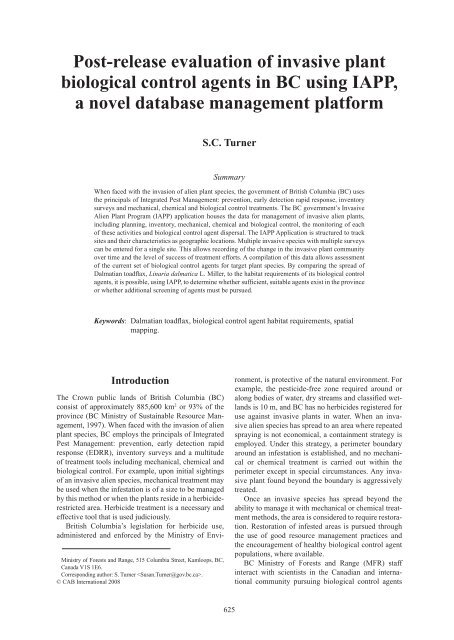

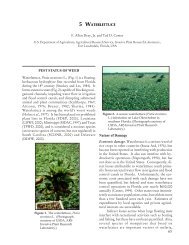

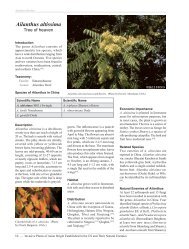
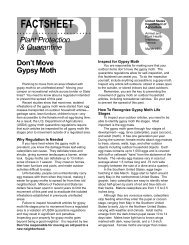
![A Guide to the Control and Management of Invasive Phragmites [PDF]](https://img.yumpu.com/27321025/1/190x190/a-guide-to-the-control-and-management-of-invasive-phragmites-pdf.jpg?quality=85)
